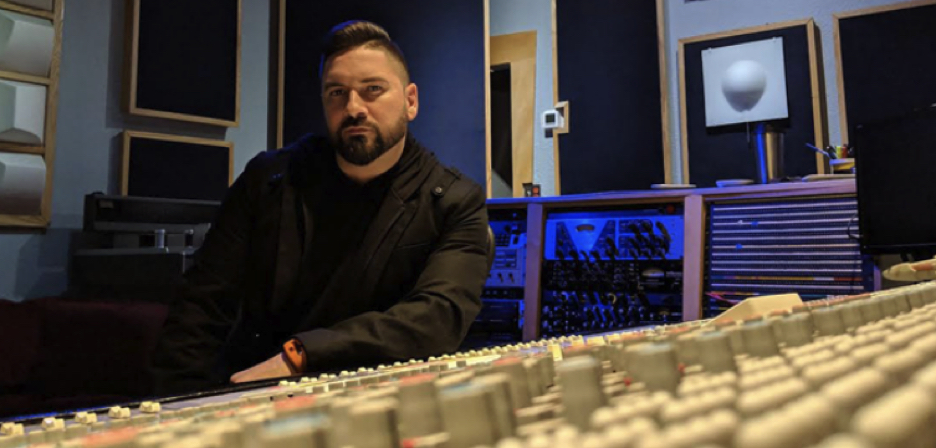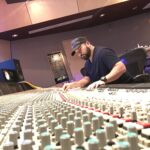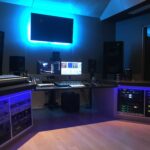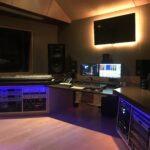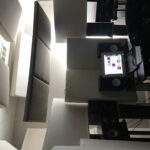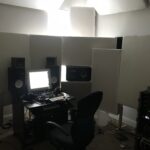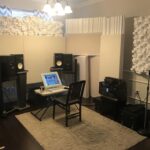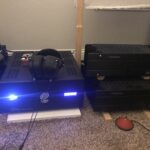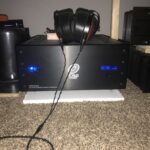Making “Mixing From Home” Magnificent
Recording engineer/music producer Francesco Benvenuto is able to mix music from his makeshift bedroom studio during COVID—just in time for the Latin Grammys —thanks to Torus Power, great monitor speakers, and acoustic treatment.
Francesco Benvenuto is a recording / mixing engineer, music producer, and educator based in Dallas who focuses on Urban and Latin Music. Normally, he works in the multi-million-dollar Luminous Sound Studio where he engineers and teaches, but when the pandemic hit, that all changed. Dramatically.
“During COVID, we had to take all the equipment home and try to make it work,” says Francesco. “We have all this analog equipment that truly needs the right electric power to really run decently. When I set up the system at home initially, the result wasn’t what I was looking for. It was sounding very noisy, and I was frustrated.”
Francesco reached out to colleagues, as well as dear friend and International Music mixing and mastering maestro Luca Pretolesi, an avid Torus Power fan. Luca turned Francesco on to the company, and Francesco began talks with Ross Whitney, Technical Sales Specialist & Customer Support at Torus Power.
“Ross told me to put in a kilowatt meter and see what kind of electricity I was getting. Right off the bat, I really liked that he had a lot of experience and gave me advice even before I purchased anything, expanding my knowledge on electrical power,” says Francesco.
While Ross’ tips helped him beef up his electricity, Francesco still chose to purchase an AVR 20 unit from Torus Power, which the company delivered to him immediately in order to help meet a tight deadline for the Latin Grammys. “Although we were in the middle of a pandemic, the Latin Grammys opened their portal for submissions and some of my clients, who were nominated in previous years, were rushing to finish their productions on time, to get it submitted even if it was literally last minute. It was a very tight turnaround, but I was able to move quick and make the right decisions for my clients to tailor their needs, which made them very happy. Cheers to that!” says Francesco, who went on to say how critical it was to get such quick support from Torus Power.
AVR stands for Automatic Voltage Regulation and it works like this: Under ideal conditions, like back in Francesco’s professional studio environments—including Empire Sound (where he previously worked) and now at Luminous Sound—when the supplied power line is stable and dependable, you may not need voltage regulation. In that case, equipment can operate within the normal tolerance of the line voltage. In reality, however, the power supplied to most areas is less than ideal due to outdated power grids. The power regularly drops or rises beyond the acceptable range.
These voltage sags, brownouts, and surges can stress components and shorten equipment life. In the worst case, catastrophic events can destroy valuable equipment. In such real-world conditions, Torus Powers’ automatic voltage regulation (AVR) units can protect your equipment and improve performance. The technique uses a micro-processor to monitor and control the voltage, seamlessly switching the multi-tapped toroidal transformer to ensure the voltage powering connected equipment remains in the optimal range. In the event of a high or low incoming mains voltage fault condition, the unit automatically disconnects power to the connected equipment, adding another level of protection.
“When I installed the AVR 20, I was blown away, and I am not easily impressed. I’ve had years of experience listening to very high-quality stuff, and this is a whole ‘nother level,” says Francesco. “When I plugged in my studio monitors, all of a sudden they reacted differently. I heard none of that noise. And the soundstage, depth, everything became bigger. There is a saying in the recording industry that ‘you can’t mix what you can’t here’. And now, I was hearing every single detail.”
This turned out to be a blessing and a curse because it exposed details in Francesco’s previous mixes done before the AVR 20 unit was installed that weren’t always positive: “I opened up a recent project and came to find out I was way off (thank God for mastering engineers). The mix was drowning in reverb and all that white noise had masked it. When I had the Torus Power unit working with the speakers, the white noise was gone and all that was left was huge reverb. Sad, but good for me to know. Now every project that I work on using Torus Power, I have much more detailed response. I can hear what’s going on and make the right adjustments and decisions. And the clients have been very happy with the work.”
When Francesco plugged in the rest of his gear, he felt as if every piece of equipment had gotten an upgrade running through the Torus Power AVR unit. “It even felt like the bass was deeper. It was full and present. I own a full Dangerous Music system, which is like the Rolls-Royce of audio equipment gear. It felt like I finally fed the power this system was hungry for. The gear now operated at a higher capacity, which felt like my setup got upgraded from a $30k system to a $300k system.”
Most recently, he went into Luminous Sound to play back some of the work he’d recorded in his makeshift bedroom studio. “I could not believe that it was my work from home. They have a big club system. I played a top-of-the-chart song, and immediately switched to mine to compare. My bass was huge and hitting hard, I can’t believe I got those results from a bedroom. Little did I know power was going to make such a big difference. I am so confident, it’s hard now going back to mix in the studio. It’s unorthodox but mixing at home is working.”
Aside from the significant boost his recordings got from clean power, Francesco recommends at-home engineers/producers pay attention to the audio in their space, using good speakers for monitors. (He uses Focal Trio 6B monitors, ATC-SEM20s, and Yamaha NS10s.) “If your mix can sound good on average speakers and translates accurately between your monitors, it will sound great anywhere,” says Francesco.
While monitoring is important, if you are mixing from home, the challenge is really the room, which obviously is not designed for sound. He recommends, among other acoustic treatments, to focus on the back wall to absorb all that soundwave shooting from the monitors, so they don’t bounce back to the front of the room. “If you have the wave shooting from the speakers and those bounce back and meet each other, then you will get dips in your audio. Very thick bass trap absorption on your back wall will help the frequencies stay back there.”
With clean power, great monitor speakers, and a little acoustic treatment, according to Francesco, one can mix from home and get incredible results. And not only can you mix from home, but your mixes might also just sound better than when executed at the studio!
